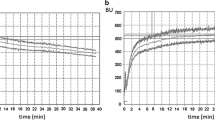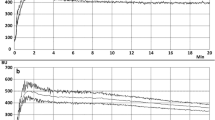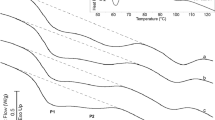Abstract
Four gluten-free (GF) breads produced using commercial GF mixes with different formulations were characterized during 1 week of storage and compared to wheat-flour-based bread (STD), in terms of texture (texture profile analysis), amylopectin retrogradation (differential scanning calorimetry) and water status (moisture content, frozen water content by differential scanning calorimetry and 1H nuclear magnetic resonance—NMR mobility by a low-field spectrometer). GF fresh breads were significantly harder, less cohesive and less springy than STD. Water status indicated higher water availability in GF breads, depending on formulation, with higher moisture and frozen water content that was also reflected in a higher molecular mobility (1H spin–spin NMR relaxation time). Furthermore, limited changes in moisture and frozen water contents were observed in GF bread, and therefore, textural changes in these GF products were mostly related to retrograded amylopectin. Statistical analysis with PCA (principal component analysis) allowed to identify the most important factors in the GF bread staling process. The effect of formulation (GFs vs STD) was related to water status descriptors and the effect of storage to textural properties, retrograded amylopectin parameters, as well as the mobility of the more rigid protons.




Similar content being viewed by others
References
Moore MM, Schober TJ, Dockery P, Arendt EK (2004) Textural comparisons of gluten-free and wheat-based doughs, batters, and breads. Cereal Chem 81:567–575
Cappa C, Lucisano M, Mariotti M (2013) Influence of Psyllium, sugar beet fibre and water on gluten-free dough properties and bread quality. Carbohydr Polym 98:1657–1666
Capriles VD, Arêas JA (2014) Novel approaches in gluten-free breadmaking: interface between food science, nutrition, and health. Compr Rev Food Sci Food Saf 13:871–890
Demirkesen I, Campanella OH, Sumnu G, Sahin S, Hamaker BR (2014) A study on staling characteristics of gluten-free breads prepared with chestnut and rice flours. Food Bioprocess Technol 7:806–820
Ahlborn GJ, Pike OA, Hendrix SB, Hess WM, Huber CS (2005) Sensory, mechanical, and microscopic evaluation of staling in low-protein and gluten-free breads. Cereal Chem 82:328–335
Zannini E, Jones JM, Renzetti S, Arendt EK (2012) Functional replacements for gluten. Annu Rev Food Sci Technol 3:227–245
Gray JA, Bemiller JN (2003) Bread staling: molecular basis and control. Compr Rev Food Sci Food Saf 1:1–21
Fadda C, Sanguinetti AM, Del Caro A, Collar C, Piga A (2014) Bread staling: updating the view. Compr Rev Food Sci Food Saf 13:473–492
Gallagher E, Gormley TR, Arendt EK (2004) Recent advances in the formulation of gluten-free cereal-based products. Trends Food Sci Technol 15:143–152
Osella CA, Sánchez HD, Carrara CR, de la Torre MA, Pilar Buera M (2005) Water redistribution and structural changes of starch during storage of a gluten-free bread. Starch-Stärke 57:208–216
Sciarini LS, Ribotta PD, León AE, Pérez GT (2010) Influence of gluten-free flours and their mixtures on batter properties and bread quality. Food Bioprocess Technol 3:577–585
Ziobro R, Korus J, Juszczak L, Witczak T (2013) Influence of inulin on physical characteristics and staling rate of gluten-free bread. J Food Eng 116:21–27
Masure HG, Fierens E, Delcour JA (2016) Current and forward looking experimental approaches in gluten-free bread making research. J Cereal Sci 67:92–111
Sereno NM, Hill SE, Mitchell JR, Scharf U, Farhat IA (2007) Probing water migration and mobility during the ageing of bread. In: Farhat IA, Belton PS, Webb GA (eds) Magnetic resonance in food science: from molecules to man. RSC Publishing, London
Bosmans GM, Lagrain B, Ooms N, Fierens E, Delcour JA (2013) Biopolymer interactions, water dynamics, and bread crumb firming. J Agric Food Chem 61:4646–4654
Curti E, Carini E, Tribuzio G, Vittadini E (2014) Bread staling: effect of gluten on physico-chemical properties and molecular mobility. LWT Food Sci Technol 59:418–425
Curti E, Carini E, Tribuzio G, Vittadini E (2015) Effect of bran on bread staling: physico-chemical characterization and molecular mobility. J Cereal Sci 65:25–30
Purhagen JK, Sjöö ME, Eliasson AC (2012) The anti-staling effect of pre-gelatinized flour and emulsifier in gluten-free bread. Eur Food Res Technol 235:265–276
Hager AS, Bosmans GM, Delcour JA (2014) Physical and molecular changes during the storage of gluten-free rice and oat bread. J Agric Food Chem 62:5682–5689
Carini E, Scazzina F, Curti E, Fattori F, Mazzeo T, Vittadini E (2015) Physicochemical, sensory properties and starch in vitro digestion of gluten-free breads. Int J Food Sci Nutr 66:867–872
ISO International Organization for Standardization. Method 1666 (1996) Determination of moisture content—oven-drying method
AOAC Association of Official Methods for Analysis. Method 996.11 (2005) Starch (total) in cereal products. Amyloglucosidase-amylase method
AOAC Association of Official Methods for Analysis. Method 992.23 (1998) Crude protein in cereal grains and oilseeds
AOAC Association of Official Methods for Analysis. Method 991.43 (1995) Total, Soluble, and Insoluble Dietary Fibre in Foods
AOAC Association of Official Methods for Analysis AOAC Association of Official Methods for Analysis
ISO International Organization for Standardization. Method 2171 (2007) Cereals, pulses and by-products—Determination of ash yield by incineration
AACC International. Approved methods of analysis, 11th ed. Method 54-21.02. Rheological behavior of flour by farinograph: constant flour weight procedure January 6, 2011. AACC International: St. Paul, MN, U.S.A. http://dx.doi.org/10.1094/AACCIntMethod-54-21.02
Russell PL (1983) A kinetic study of bread staling by differential scanning calorimetry and compressibility measurements. The effect of different grists. J Cereal Sci 1:285–296
Le Grand F, Cambert M, Mariette F (2007) NMR signal analysis to characterize solid, aqueous, and lipid phases in baked cakes. J Agric Food Chem 55:10947–10952
Ronda F, Roos YH (2011) Staling of fresh and frozen gluten-free bread. J Cereal Sci 53:340–346
Lazaridou A, Duta D, Papageorgiou M, Belc N, Biliaderis CG (2007) Effects of hydrocolloids on dough rheology and bread quality parameters in gluten-free formulations. J Food Eng 79:1033–1047
Hallberg LM, Chinachoti P (2002) A fresh perspective on staling: the significance of starch recrystallization on the firming of bread. J Food Sci 67:1092–1096
Ribotta PD, Le Bail A (2007) Thermo-physical assessment of bread during staling. LWT Food Sci Technol 40:879–884
Kerch G, Rustichelli F, Ausili P, Zicans J, Meri RM, Glonin A (2008) Effect of chitosan on physical and chemical processes during bread baking and staling. Eur Food Res Technol 226:1459–1464
Ziobro R, Korus J, Witczak M, Juszczak L (2012) Influence of modified starches on properties of gluten-free dough and bread. Part II: quality and staling of gluten-free bread. Food Hydrocolloids 29:68–74
Eliasson AC, Bergenståhl B, Nilsson L, Sjöö M (2013) From molecules to products: some aspects of structure-function relationships in cereal starches. Cereal Chem 90:326–334
Eliasson AC (1983) Differential scanning calorimetry studies on wheat starch-gluten mixtures: II. Effect of gluten and sodium stearoyl lactylate on starch crystallization during ageing of wheat starch gels. J Cereal Sci 1:207–213
Every D, Gerrard JA, Gilpin MJ, Ross M, Newberry MP (1998) Staling in starch bread: the effect of gluten additions on specific loaf volume and firming rate. Starch-Stärke 50:443–446
Ottenhof MA, Farhat IA (2004) The effect of gluten on the retrogradation of wheat starch. J Cereal Sci 40:269–274
Curti E, Carini E, Diantom A, Vittadini E (2016) The use of potato fibre to improve bread physico-chemical properties during storage. Food Chem 195:64–70
Curti E, Carini E, Bonacini G, Tribuzio G, Vittadini E (2013) Effect of the addition of bran fractions on bread properties. J Cereal Sci 57:325–332
Author information
Authors and Affiliations
Corresponding author
Ethics declarations
Conflict of interest
Carini, Curti, Fattori, Paciulli and Vittadini declare that they have no conflict of interest.
Human or animal rights
This article does not contain any studies with human or animal subjects.
Rights and permissions
About this article
Cite this article
Carini, E., Curti, E., Fattori, F. et al. Staling of gluten-free breads: physico-chemical properties and 1H NMR mobility. Eur Food Res Technol 243, 867–877 (2017). https://doi.org/10.1007/s00217-016-2801-2
Received:
Revised:
Accepted:
Published:
Issue Date:
DOI: https://doi.org/10.1007/s00217-016-2801-2




